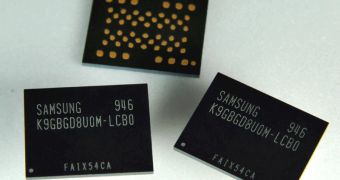Minutes after it announced the mass production of 3-bit MLC NAND chips, Samsung revealed that it had also been working on implementing Asynchronous Double Data Rate (DDR) interface into its NAND memory, effectively creating 32 gigabit MLC NAND memory chips based on the 30nm process. This development comes only eight months after the Korean company unveiled its first 30nm-class 32Gb MLC NAND and the new memory is capable of double data transfer rates without the need to increase power consumption.
The fresh memory will be usable in SSDs for PCs, premium SD memory cards for smartphones and in Samsung's proprietary moviNAND memory. Its usage in such devices is explained by the significantly increased read speed, namely 133 megabits, compared to the single data rate (SDR) chips that only have an overall performance of 40Mbps. In addition, premium memory cards using the memory will have 60Mbps read speeds, which is 300% better than SDR NAND-based cards that only have 17Mbps.
"With the new DDR MLC NAND, double data rate transmission can be achieved without increasing power consumption, giving designers a lot more latitude in introducing diverse CE devices," said Soo-In Cho, executive vice president and general manager of the Memory Division at Samsung Electronics. "Samsung's accelerated push toward providing memory solutions at much higher speeds will enable faster introduction of high-performance mobile devices that deliver added convenience and greater value to consumers."
Besides its use in PCs and smartphones, the new technology will go very well with PMPs (personal media players), MP3 players and car navigation systems thanks to its high density and performance. The company has already shipped the initial production of its DDR NAND to its OEMs at the end of November.
Gartner Dataquests research firm considers that the global NAND flash memory market will most likely grow from the 2009 estimated US$13.8 billion to US$23.6 billion by 2012.

 14 DAY TRIAL //
14 DAY TRIAL //